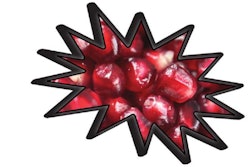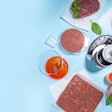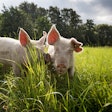Palatability can be influenced by several factors, such as food composition, previous experiences of the animals and genetics (Bradshaw 2006), with processing and quality of the raw materials which will compose the final product also playing an important role (Bazolli et al. 2015).
The sensory analysis of diets by pets is mostly based on preference and/or acceptance tests. Such trials can be performed in in-home panels of naïve pets and in expert panels of animals that have been trained to discriminate foods with different nutritional and sensory properties. In general, the results are based on the amount of food consumed during a defined period (Tobie et al. 2015).
Solutions for improving pet food palatabilty are usually available in the market in both dry and liquid presentations, and are based on hydrolysed meat tissues mixed with yeast, which is considered palatable, with a marked umami taste, due to its content of glutamic acid and nucleotides (Martins et al. 2014).
Palatability’s importance within the pet food industry
Palatability still remains an important trend and an important driver for the design and development of new products within the pet food industry. Over the last several years, a significant number of products that have come to the market have presented claims related to palatability: high palatability, highly palatable or making reference to specific flavors such as chicken, beef or fish (Innova Market Insights). Upon the increasing competition within this industry, with lot of new products being launched in the market annually, new solutions for promoting differentiation are needed.
Trials in dogs and cats
For assessing the effects of different processes on the palatability of yeast derivatives, four prototypes from the same yeast basis were developed in the pilot plant of Biorigin R&D Center (Brazil): inactive dry yeast (IDY, which consisted of an inactivation and drying of the yeast cream); autolysis (no enzymes), hydrolysis 1 (using enzyme 1, which generated a higher amount of extract, with a consequently higher content of soluble material) and hydrolysis 2 (using enzyme 2, which generated an intermediary content of soluble material).
Palatability trials were performed in expert kennel and cattery located in United States, according to the following protocols: the prototypes were incorporated by coating at 0.5% in the same basis of a extruded dry food and provided once a day for both dogs and cats, during 2 days. In the dog trials, Pointer and Beagle dogs were provided 800g of each test food, which was available during a 30-minute period. In the cat trials, both short and longhair cats were provided 150g of each test food, which was available during an 18-hour period. The four prototypes were tested in pairs with each other, resulting in a total of six tests for dogs and six tests for cats. Statistical analysis of the data was performed using Microsoft Excel, through the comparison of the means by T test.
Results indicate that all the tested foods were well consumed and animals kept their body weight. In general, the prototypes “autolysis,” “hidrolysis 1” and “hidrolysis 2” were preferebly consumed over the IDY one (P<0.05) for both dogs and cats. For dogs (see Figure 1), both prototypes “hidrolisys 1” and “hidrolysis 2” showed better palatability in comparison to “autolysis” (P<0.05). Moreover, “hidrolysis 1” was preferebly consumed over “hidrolysis 2” (P<0.05), showing the best results among the tested prototypes. For cats (see Figure 2), there was a trend of preference (P>0.05) by the prototype “autolysis” over the others, which was not confirmed in the second day of the test. Comparing the two different hidrolysis, there was a trend of preference by the “hidrolysis 1” (P>0.05). For cats, it is possible to affirm that except the prototype IDY, all the others had a similar performance.
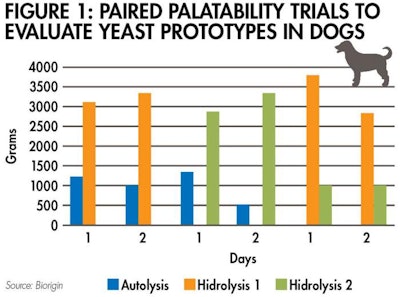
For dogs, both prototypes “hidrolisys 1” and “hidrolysis 2” showed better palatability in comparison to “autolysis.”
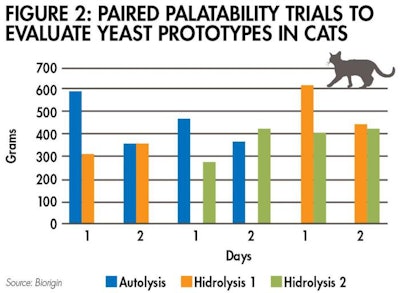
For cats, it is possible to affirm that except the prototype IDY, all the others had a similar performance.
Conclusion
Solutions containing yeast extract and hydrolyzed yeast have shown to have good palatability for both dogs and cats. The yeast processing, through autolysis and hidrolysis processes, was an effective tool to improve a product palatability, since the processed forms were shown to be more palatable than the inactive one. Hence, processed yeast can be used as a solution for pet food differentiation.
References
Bradshaw, J.W.S. The evolutionary basis for the feeding behaviour of domestic dogs (Canis familiaris) and cats (Felis catus). The Journal of Nutrition, v. 136 (7 Suppl.), p. 1927S-1931S, 2006.
Bazolli, R. et al. Effect of the particle size of maize, rice and sorghum in extruded diets for dogs on starch gelatinization, digestibility and fecal concentration of fermentation products. Journal of Animal Science, v. 93, p. 2956-2966, 2015.
Martins, M. et al. Brewer’s yeast and sugarcane yeast as protein sources for dogs. Journal of Animal Physiology and Animal Nutrition, v. 98, p. 948-957, 2014.
Tobie, C. et al. Assessing food preferences in dogs and cats: a review of the current methods. Animals, v. 5, p. 126-137, 2015.


